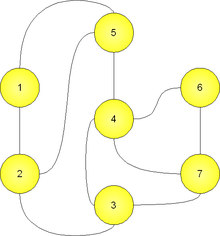Path vector protocol
A path vector protocol is a routing - protocol for computer networks , each of which carries the vector for the individual elements (paths) that this element has taken through the network in the spread. A path can easily be recognized as a loop through the vector if the receiving system is already part of the vector. This avoids infinity problems.
Basic principle
In order to be able to find the best way to a certain destination in a network, the routers must have a list of the possible paths and the associated vectors, i.e. paths. In the various techniques of these routing protocols, the path vector protocols belong to the distance vector protocols . A router sends the paths that can be reached through it to all neighboring routers. At the beginning, the path vector is initialized with the identifier of the initiating (starting) router. Each router that receives this path examines the vector for its own identifier. If this is not included, the path with the associated vector is added to the local database. As a result, each router has the paths of the network and the associated vectors in its database.
Working method
Each router must also save the associated vector for each path element. For the example model
the database in router 7 looks like this as an excerpt:
| element | vector |
|---|---|
| 1 | 4 - 5 - 1 |
| 1 | 4 - 3 - 2 - 1 |
| 1 | 4 - 5 - 2 - 1 |
| 1 | 4 - 3 - 2 - 5 - 1 |
| ... | |
| 3 | 3 |
| 3 | 4 - 3 |
| 3 | 4 - 5 - 2 - 3 |
| 3 | 4 - 5 - 1 - 2 - 3 |
| 3 | 6 - 4 - 3 |
| ... | |
| 5 | 6 - 4 - 3 - 2 - 5 |
| 5 | 6 - 4 - 3 - 2 - 1 - 5 |
The entire table contains 42 entries. This represents a spanning tree . In this unfiltered form, the database would very quickly become very large. For this reason, for example in BGP , a path vector protocol, only the path with the shortest vector is passed on. This reduces the table to the variants that represent the best possible vectors to the target.
| element | vector |
|---|---|
| 1 | 4 - 5 - 1 |
| 1 | 3 - 2 - 1 |
| 1 | 6 - 4 - 5 - 1 |
| 2 | 3 - 2 |
| 2 | 4 - 3 - 2 |
| 2 | 6 - 4 - 3 - 2 |
| 3 | 3 |
| 3 | 4 - 3 |
| 3 | 6 - 4 - 3 |
| 4th | 4th |
| 4th | 3 - 4 |
| 4th | 6 - 4 |
| 5 | 3 - 2 - 5 |
| 5 | 4 - 5 |
| 5 | 6 - 4 - 5 |
This optimized table only contains 15 entries.
application
The routing of the Internet is based on BGP , which is a path vector protocol from the group of distance vector protocols. The IP prefix , i.e. the network address and the network mask, is used as element identification .
Each router belongs to an autonomous system (AS) and this AS is written into the path vector as an identification. In addition, guidelines are installed on the individual routers that influence when a route should be forwarded to neighboring routers.
Path vector protocols not only exchange routing data when the topology changes, but also in certain cycles to ensure consistency. Compared to link status protocols , they generally have higher convergence times .
Web links
- RFC 1771 : BGP
